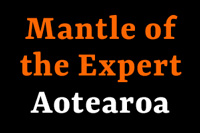Mantle of the Expert and process drama planning based on NZ historical events
In a previous post, I promised to gather and share Mantle of the Expert plans based on New Zealand historical events. Thanks to those who got in touch with suggestions. I know there are many other examples out there, so please let me know if you can recommend a published resource or if have a plan you are willing to share.
The examples listed below include some that explore broad historical issues, and a few looking at specific historical events. Where possible I have included a link to a copy of the planning, or information about where it can be found.
- One of my favourite process dramas is Trevor Sharpe’s huia beak brooch originally published on the TKI website. This explores issues of colonial history and touches on conservation too. Suitable for primary and junior drama classrooms, the planning has Mantle of the Expert qualities that could be built on to extend it into a full term’s cross curricula exploration.
- Jacob’s Secret is another great resource created by Peter O’Connor and a group of students at Waikato University in the 1990s. The booklet explores the colonisation of the Waikato, though it could be adapted to look into the history of other areas too.
- Playing our Stories – a resource for classroom drama in years 1-6, produced by Learning Media in 2006, includes another very accessible process drama by Peter O’Connor entitled Taonga. Planned as a short unit exploring different attitudes to land and family history, it definitely has the potential to be extended into a full length Mantle of the Expert. I’ve attached a scanned copy of the planning here. I trust someone will let me know if that’s against copyright regulations but I figure it’s OK since this resource was sent out to every primary school in NZ – it was designed to be shared around! Primary teachers may still be able to find hard copies lurking in a resource cupboard somewhere! If so, check out the DVD which shows the lessons being taught.
- Telling our stories – another resource produced by Learning media, this time for years 7-13, includes a terrific drama by Lyn Shillingford and Frances Reed based on the Tangiwai disaster of 1953. I’ve taught this one quite a few times and it’s powerful stuff. As in the other examples listed, this drama includes a commission, a client and a responsible team so it would be easy to run it as a full blown ‘mantle’. I’ve only got an old photocopy so the quality may not be great but, again, it may still be possible to find copies in intermediate and high school resource rooms.
- Carrie Swanson’s PhD thesis gives a detailed study of how history can also be used alongside other curriculum learning areas. By positioning students as expert scientists commissioned to re-investigate the Sinking of the Wahine in Wellington harbour in 1968, she and the classroom teacher successfully taught the history of the event alongside science principles, specifically floating and sinking and cyclones. The link takes you to Carrie’s thesis. Check out appendix B (pages 356-359) for an overview of the planning.
- Susan Battye has kindly shared her planning for a project from 1989, where drama was used across a secondary school to teach local history – in this case the history of Maungakiekie (One tree hill) in Auckland. The planning is interesting as an example of ‘rolling role’, where different groups and their teachers take responsibility for different aspects of the research. It also makes great use of the ‘person in role’ strategy by pulling in a range of adults to take on roles and meet with the students. Lots of potential for updating or adapting this one.
- And finally, this brief plan is one of mine. It’s an overview for a Mantle of the Expert experience inspired by the history of Kahikatea use in the Waikato. This link will take you to previous posts where I reflect on teaching this with a group of adult students.

Leave a Reply
Want to join the discussion?Feel free to contribute!